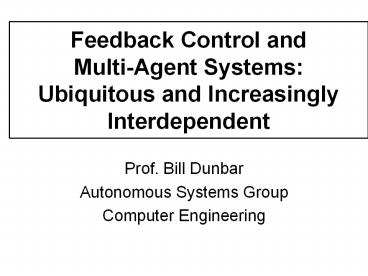Feedback Control and Multi-Agent Systems: Ubiquitous and Increasingly Interdependent - PowerPoint PPT Presentation
1 / 36
Title:
Feedback Control and Multi-Agent Systems: Ubiquitous and Increasingly Interdependent
Description:
Title: PowerPoint Presentation Author: school of engineering Last modified by: school of engineering Created Date: 11/3/2004 9:24:59 PM Document presentation format – PowerPoint PPT presentation
Number of Views:70
Avg rating:3.0/5.0
Title: Feedback Control and Multi-Agent Systems: Ubiquitous and Increasingly Interdependent
1
Feedback Control and Multi-Agent Systems
Ubiquitous and Increasingly Interdependent
- Prof. Bill Dunbar
- Autonomous Systems Group
- Computer Engineering
2
What are Systems? ANYTHING in Engineering,
usually with Dynamics.
- Some familiar examples
- How do we describe systems?
- with math!
3
Math Describing Diverse Engineering Systems in a
Common Way
4
Control Systems are Hidden Engineering Systems
- A Control System is a device in which a sensed
quantity is used to modify the behavior of a
system through computation and actuation.
5
My (and Potentially Your) Research
- Robotics
- Exploration
- Toys
- Competition (soccer)
- Automated Freeways
- Supply Chain Management
6
EventuallyA Fully Autonomous Vehicle Off-Road
Dessert Race
7
The Potential is Enormous
- Researchers at Caltech are working toward the
math model of the fruit fly system, with the
ultimate objective of making a micro- mechanical
fly!
8
Distributed Optimization-Based Control of
Multiagent Systems
Ass. Prof. Bill Dunbar Autonomous Systems
Group Computer Engineering
9
Multiagent Systems are Everywhere
- The Internet
- Air traffic control
- The Power Grid
- Autonomous Formations
- Control Problems with
- Subsystem dynamics
- Shared resources (constraints)
- Communications topology
- Shared objectives
10
Multiagent Systems Inherently Distributed and
Cooperative
- Multiagent System
- autonomous agents
- communication network
Distributed local decisions based on local
information.
Cooperative agents agree on roles dynamically
coordinate.
11
A Relevant Decision Method Receding Horizon
Control (RHC)
RHC uses optimization to find feasible/optimal
plans for near future.
To mitigate uncertainty, plan is revised after a
short time.
computed
12
Mathematics of RHC is Finite Horizon Optimal
Control
13
Convergence of RHC Requires Appropriate Planning
Horizon and Terminal Penalty
Theoretical conditions sufficient in absence of
explicit uncertainty.
Mayne et al., 2000
14
RHC Compared to Other Control Techniques
- Gives planning feedback with built-in
contingency plans. - Only technique that handles state and control
constraints explicitly. - Tradeoff computationally intensive.
15
RHC Successful in Applications Process to
Flight Control
Caltech flight control experiment Tracking ramp
input of 16 meters in horizontal, step input of
1m in altitude. RHC updates at 10 Hz,
trajectories generated by NTG software package.
Movie
16
RHC Admits Cooperation
Get 1 to pump, 2 follow 1 3 follow 2.
Decoupled dynamics
Avoid collision
17
RHC of Multiagent Systems Whats Missing?
Enables autonomy of single agent.
Amenable to cooperation for multiple agents.
18
My Contribution A Distributed Implementation of
RHC
Distributed local decisions based on local
information.
Decoupled subsystem dynamics/constraints, Coupled
cost L
19
Solution of Sub-problems requires Assumed Plan
for Neighbors
Agent 3 ?
20
Compatibility of Actual and Assumed Plans via
Constraint
Compatibility constraint
Assumed plan
21
Distributed Implementation Requires Synchrony
Common Horizon T
22
Conditions for Theory are General
23
Convergence Conditions Same as Centralized plus
Bound on Update Period
Dunbar Murray, Accepted to Automatica, June,
2004
24
Venue Multi-Vehicle Fingertip Formation
25
Decomposition of Coupled Cost
26
Simulation Parameters
4
2
27
Centralized RHCBenchmark for Comparison
28
Centralized RHC Simulation
29
Distributed RHC is Comparable to Centralized RHC
30
Distributed RHC Simulation
31
Naïve Approach Produces Less Desirable Performance
32
Naïve Approach Bad Overshoot
33
Summary of Contribution
- Distributed implementation of RHC is provable
convergent, performs well, and is applicable to a
class of Multiagent Systems - Distributed cooperative structure
- Local decisions based on local information
- Decomposition and incorporation of compatibility
constraint - Coordination via sharing feasible plans
- Applicable for
- Heterogeneous nonlinear dynamics
- Generic objective function (need not be
quadratic) - Coupling constraints
34
Conclusions
- Theory conservative useful as guideline for
implementation. - Scalable computational complexity independent of
Na communication complexity independent of Na
but dependent on Ni (size of neighborhood). - Communicating trajectories more intensive than
traditional decentralized control, but not too
bad, given smoothness properties. - Less communication than required by
parallelization. Tradeoff not recovering
centralized solution to original problem, but
that of a modified problem.
35
Current and Ongoing Work
- Theoretically
- Locally synchronous and asynchronous versions
- DONE Coupled subsystem dynamics. Potential
applications - Process control
- Supply chain management
- Reduced order contingency plans
- Connection with rollout algorithms in MDPs
36
Current and Ongoing Work
- Applications
- Coordinated UAVs
- Mobile Sensor Networks
- Robots coordinating for toxin detection
- Intelligent Transportation Systems
- Automated freeways
- Semi-automated Air Traffic Control
- Interdisciplinary examples
- Supply chain management (Business)
- Power/Water resource management































